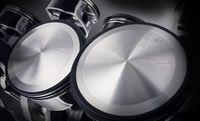.
HEMI: Difference between revisions
ChargerSRT8 (talk | contribs) (Linked 392 Page) |
ChargerSRT8 (talk | contribs) No edit summary |
||
| Line 19: | Line 19: | ||
== Street HEMI == | == Street HEMI == | ||
[[Image: | [[Image: HEMI_Pistons.jpg|thumb|200px|right|370 cid HEMI]] In 1966, the Street Hemi became available. The street version 426 differed from the race Hemi by a lower compression ratio (10.25:1), milder valve timing, and different intake and exhaust manifolds. Cast iron heads were used instead of aluminum. The Street Hemi came with dual Carter 4-barrel carbs mounted on an aluminum dual-plane intake manifold. The engine's advertised horsepower and torque ratings stayed at 425 hp at 5000 rpm and 490 foot-pounds of torque at 4000 rpm. Many people claim the output was closer to 500 hp. The 426 Hemi was a $1,100 option on many models and came with either a 4-speed manual or a Torque Flite automatic transmission. | ||
In 1968, the Plymouth Road Runner made its debut with a base price of $2,986. For an additional $714.30, it could be fitted with a Hemi. Out of the 44,599 Road Runners made in 1968, only 1019 were delivered with a Hemi engine. | In 1968, the Plymouth Road Runner made its debut with a base price of $2,986. For an additional $714.30, it could be fitted with a Hemi. Out of the 44,599 Road Runners made in 1968, only 1019 were delivered with a Hemi engine. | ||
Revision as of 03:52, 31 December 2007
In the late 1930s Chrysler began experimenting with different types of engine designs to improve the performance of their cars. The first hemispherical shaped (half sphere) combustion chamber engine was developed prior to World War II, but it was used very little. During the 1950s, Chrysler continued to modify this engine design for a number of passenger cars. It was not until 1964 that the 426 Hemi engine caught the racing world by surprise.
In 1951, Chrysler introduced the Hemi V8 engine to the public. This engine had 331 cubic inches and featured hemispherical combustion chambers. This engine produced 180 horsepower at 4000 rpm. The first cars to host this new engine were the New Yorker and Saratoga lines. Chrysler, DeSoto, Dodge, Imperial, and Plymouth were the first cars to offer a Hemi engine as an option. Chrysler referred to these engines as the "Red Ram", "Firedome" and "Firepower" motors. These early 301, 331, 354, and 392 ci motors, had little in common with the 426 except for the basic valve train arrangement and spark plug location.
In 1955 Chrysler introduced the first car in North America to produce 300 horsepower and 345 pounds of torque. The 1955 Chrysler C300 featured a 331 ci Hemi with 345 pounds of torque at 3200 rpm.
Horsepower for the early Hemi peaked in 1958 with a dual 4-barrel version of the 392 rated at 390 hp.
The Race HEMI
In the early 60s, Chrysler released two new engines -- a 413 and 426 ci with a wedge shaped cylinder head design. These engines were called the "Max Wedge". The "Max Wedge" was making a name for itself on the drag strips and Chrysler decided it was time to be taken seriously in the NASCAR circuit. The 426 Max Wedge was strictly a race engine and was offered in Plymouths as the Super Stock 426 and in Dodges as the 426 Ramcharger.
The Hemi engine reintroduced in 1964 was the called the "Race Hemi". This engine was developed from the 426, but featured a Hemi-head. The result was the 426 Hemi.
The 426 had iron heads, a 12.5:1 compression ratio, and single Holley 4-bbl carburetor mounted on a cross ram manifold. Engines intended for the drag-strip had an aluminum cross ram with dual Holleys. In 1965 the A-990 race Hemi was introduced with aluminum heads and magnesium intake manifolds.
Street HEMI
In 1966, the Street Hemi became available. The street version 426 differed from the race Hemi by a lower compression ratio (10.25:1), milder valve timing, and different intake and exhaust manifolds. Cast iron heads were used instead of aluminum. The Street Hemi came with dual Carter 4-barrel carbs mounted on an aluminum dual-plane intake manifold. The engine's advertised horsepower and torque ratings stayed at 425 hp at 5000 rpm and 490 foot-pounds of torque at 4000 rpm. Many people claim the output was closer to 500 hp. The 426 Hemi was a $1,100 option on many models and came with either a 4-speed manual or a Torque Flite automatic transmission.
In 1968, the Plymouth Road Runner made its debut with a base price of $2,986. For an additional $714.30, it could be fitted with a Hemi. Out of the 44,599 Road Runners made in 1968, only 1019 were delivered with a Hemi engine.
1971 was the last year for the 426 Hemi option. Between the years 1966-1971 the 426 Hemi option was ordered in approximately 10,000 cars. Very few changes were made to the Hemi motor though its seven year run. Concerns about emissions led to major detuning of all high performance engines. Insuring a Hemi car was also a bit difficult.
In 1993 Mopar began manufacturing a new Hemi block which made parts once again available. A complete Hemi engine is not currently available, but one can be assembled for about $10,000. Today, restored original Hemi cars carry a very high price tag.
HEMI List
- 241 Cubic Inch
- 259 Cubic Inch
- 270 Cubic Inch
- 276 Cubic Inch
- 291 Cubic Inch
- 315 Cubic Inch
- 325 Cubic Inch
- 330 Cubic Inch
- 331 Cubic Inch
- 341 Cubic Inch
- 345 Cubic Inch (5.7L)
- 354 Cubic Inch
- 370 Cubic Inch (6.1L)
- 392 Cubic Inch (6.4L)
- 426 Cubic Inch
- 472 Cubic Inch
- 528 Cubic Inch



